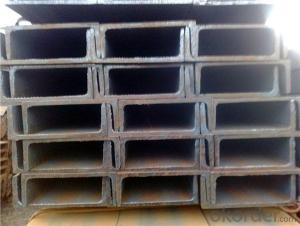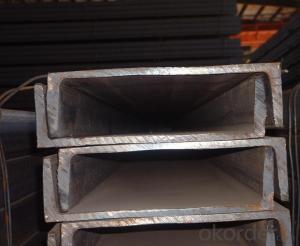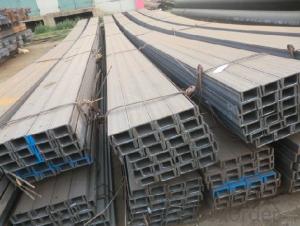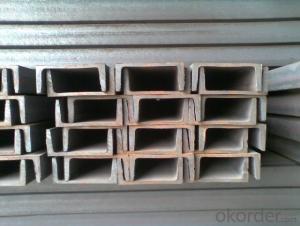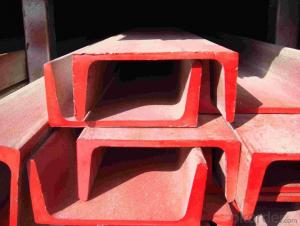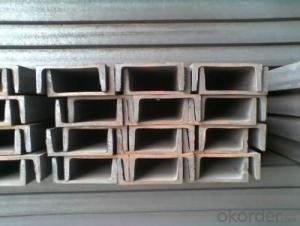Steel C-Channel (Q235, Q345, Q195)
- Loading Port:
- Tianjin
- Payment Terms:
- TT or LC
- Min Order Qty:
- 2000 PCS
- Supply Capability:
- 48000 PCS/month
OKorder Service Pledge
OKorder Financial Service
You Might Also Like
OKorder is offering high quality Steel C-Channel (Q235, Q345, Q195) at great prices with worldwide shipping. Our supplier is a world-class manufacturer of steel, with our products utilized the world over. OKorder annually supplies products to European, North American and Asian markets. We provide quotations within 24 hours of receiving an inquiry and guarantee competitive prices.
Product Applications:
Steel C-Channel (Q235, Q345, Q195) are ideal for structural applications and general fabricating, as well as transportation and engineering.
Product Advantages:
OKorder's Steel Channels are durable, strong, and resists corrosion.
Main Product Features:
· Premium quality
· Prompt delivery & seaworthy packing (15-30 days after receiving deposit)
· Corrosion resistance
· Can be recycled and reused
· Lighter than concrete
· Professional Service
· Competitive pricing
Product Specifications:
Standard: AISI, ASTM, BS, DIN, GB, JIS
Grade: Q235, Q345, Q195
Height: 90 – 400mm
Thickness: 0.4 – 4mm
Length: As per customer request
Max Dimensions: 120*50*20mm
Surface: Painted, galvanized, as per customer request
Color: Black, silver
Place of Origin: Tianjin, China
FAQ:
Q1: Why buy Materials & Equipment from OKorder.com?
A1: All products offered byOKorder.com are carefully selected from China's most reliable manufacturing enterprises. Through its ISO certifications, OKorder.com adheres to the highest standards and a commitment to supply chain safety and customer satisfaction.
Q2: How do we guarantee the quality of our products?
A2: We have established an advanced quality management system which conducts strict quality tests at every step, from raw materials to the final product. At the same time, we provide extensive follow-up service assurances as required.
Q3: How soon can we receive the product after purchase?
A3: Within three days of placing an order, we will begin production. The specific shipping date is dependent upon international and government factors, but is typically 7 to 10 workdays.
Q4: What makes stainless steel stainless?
A4: Stainless steel must contain at least 10.5 % chromium. It is this element that reacts with the oxygen in the air to form a complex chrome-oxide surface layer that is invisible but strong enough to prevent further oxygen from "staining" (rusting) the surface. Higher levels of chromium and the addition of other alloying elements such as nickel and molybdenum enhance this surface layer and improve the corrosion resistance of the stainless material.
Q5: Can stainless steel rust?
A5: Stainless does not "rust" as you think of regular steel rusting with a red oxide on the surface that flakes off. If you see red rust it is probably due to some iron particles that have contaminated the surface of the stainless steel and it is these iron particles that are rusting. Look at the source of the rusting and see if you can remove it from the surface.
Images:


- Q: Can steel channels be used for mezzanine flooring?
- Yes, steel channels can be used for mezzanine flooring. Steel channels are often used in the construction of mezzanine floors due to their strength, durability, and load-bearing capacity. They provide a sturdy and reliable base for elevated platforms and can support heavy loads. Additionally, steel channels can be easily combined with other materials such as steel decking or plywood to create a solid flooring surface. Overall, steel channels are a popular choice for mezzanine flooring due to their structural integrity and ability to withstand heavy foot traffic and equipment.
- Q: Can steel channels be used in residential construction?
- Indeed, residential construction can incorporate steel channels. These steel channels, which possess a C-shaped cross-section, serve as structural supports made of steel. In the realm of building construction, they are widely utilized for the purpose of providing stability and support to diverse elements like walls, floors, and roofs. The utilization of steel channels in residential construction yields numerous benefits, including their exceptional strength-to-weight ratio, durability, and resistance to fire, rot, and pests. Moreover, they exhibit versatility and find usefulness in a range of applications such as framing, wall studs, and roof trusses. Furthermore, the adaptability of steel channels allows for easy customization and cutting to specific lengths, rendering them suitable for various building designs and requirements.
- Q: Can steel channels be used in agricultural buildings?
- Yes, steel channels can be used in agricultural buildings. Steel channels are versatile structural components that provide strength and support for various applications, including agricultural buildings. They can be used for framing, roofing, and other structural elements in barns, storage sheds, livestock housing, and other agricultural structures. Steel channels are known for their durability, load-bearing capacity, and resistance to environmental factors such as moisture, pests, and fire. They are typically made from galvanized steel, which adds a protective coating to prevent rust and corrosion, making them suitable for agricultural environments with high levels of humidity and exposure to chemicals. The use of steel channels in agricultural buildings offers several advantages. They provide a strong and stable framework, allowing for larger spans and greater flexibility in design. Steel channels are lightweight, which reduces the overall weight of the structure and simplifies the construction process. Additionally, steel is a recyclable material, making it an environmentally friendly choice for agricultural buildings. In summary, steel channels can be effectively utilized in agricultural buildings due to their strength, durability, and versatility. They provide a reliable and cost-effective solution for constructing robust and long-lasting structures in the agricultural industry.
- Q: What are the different installation techniques for steel channels?
- Steel channels can be installed in various ways, depending on their intended use and specific requirements. Here are a few commonly used techniques: 1. Welding: By utilizing a welding machine, the steel channels can be fused to the supporting structure, creating a sturdy connection between the two. 2. Bolting: An alternative method involves securing the steel channels to the supporting structure using bolts. This technique is particularly useful when adjustability or removal of the channels is necessary. 3. Adhesive bonding: In certain cases, steel channels can be installed by bonding them to the supporting structure using a strong adhesive. This method is suitable when welding or bolting is not feasible. 4. Mechanical fasteners: For lighter-duty applications or temporary installations, mechanical fasteners like screws, nails, or rivets can be used to affix the steel channels. 5. Sliding or sliding-fit installation: In specific scenarios, steel channels can be easily installed by sliding them into pre-formed slots or grooves in the supporting structure. This facilitates effortless installation and removal as required. When selecting the appropriate installation technique for steel channels, it is crucial to consider the project's specific requirements, such as load-bearing capacity, durability, and ease of installation. Seeking guidance from a structural engineer or construction professional is advisable to ensure the proper installation method is chosen for the particular application.
- Q: What are the factors to consider when determining the appropriate angle of a steel channel?
- There are several factors to consider when determining the appropriate angle of a steel channel, including the load it will bear, the structural requirements, the desired strength and stability, the available space for installation, and any specific design or aesthetic considerations.
- Q: Can steel channels be used for playground equipment?
- Indeed, playground equipment can utilize steel channels. The construction industry frequently employs steel channels due to their robustness and resilience, rendering them appropriate for playground equipment. They offer a firm and secure framework capable of bearing the weight of children and enduring the constant usage. Furthermore, steel channels can be effortlessly molded and welded to form diverse structures and designs for playground equipment, including slides, climbing frames, and swing sets. Their adaptability and capacity to withstand harsh weather conditions make them a perfect choice for long-lasting and child-safe playground equipment.
- Q: Are steel channels available in different lengths?
- Different lengths of steel channels are readily available. These channels, which can also be referred to as C-channels or U-channels, are made of steel and have either a C or U shape. They are commonly utilized in construction, manufacturing, and various other industries. Manufacturers typically produce steel channels in standard lengths, although these lengths may vary depending on the specific requirements of the project and the manufacturer itself. Some standard lengths for steel channels include 10 feet, 20 feet, and 40 feet. However, custom lengths can also be manufactured to meet the unique needs of a project. The availability of different lengths provides flexibility and versatility in construction and design. Whether it is for constructing frames, supports, or other structural elements, steel channels can be cut or joined together to achieve the desired length. This adaptability makes steel channels a favored choice in various applications, as they can be easily tailored to fit specific project requirements. To sum up, steel channels are indeed available in different lengths, including both standard sizes and custom lengths. Their availability in various lengths allows for their widespread use in a wide range of construction and industrial projects.
- Q: Hello, I have a question to ask you, do a steel hoop, the outer diameter of 1688MM, with 8# steel roll, want to ask next to the long material, 8# channel 43, formula I for (1688-43) *3.14159=5168mm, this material, placed above the rolling machine to roll how, outside diameter it is more than 1688 Oh, I would like to ask, feeding formula should start rolling steel...Is it possible to stretch the roll with a profile bending machine? Can you recommend 1-2 units? It's best to have the approximate price. I'd like to consider whether I can buy one. Thank you
- Count the amount, and in turn count how much it should be minus 1688, and then do it. Or leave a little margin, roll it repaired.
- Q: Can steel channels be used in the automotive parts manufacturing industry?
- Indeed, the automotive parts manufacturing industry does utilize steel channels. Within the automotive industry, steel channels find widespread application in structural components, frames, body panels, reinforcements, and chassis parts. Their remarkable strength and durability render them apt for enduring the rigorous conditions and loads confronted by automotive parts. Moreover, steel channels boast the advantage of effortless shaping, cutting, and welding, enabling efficient customization and fabrication of automotive components. By incorporating steel channels, the automotive parts manufacturing industry guarantees the production of sturdy and dependable automotive parts.
- Q: How do steel channels contribute to building envelope performance?
- Steel channels contribute to building envelope performance in several ways. Firstly, steel channels are often used as framing elements in the construction of building envelopes. These channels provide structural support and help to distribute loads, ensuring the overall stability and integrity of the building. This is particularly important in areas with high wind or seismic activity, where the building envelope needs to be able to withstand external forces. Additionally, steel channels can be used to create a continuous air barrier within the building envelope. By properly sealing and insulating the channels, air leakage can be minimized, reducing energy loss and improving the overall energy efficiency of the building. This is crucial in terms of thermal comfort and reducing heating and cooling costs. Furthermore, steel channels can be used as part of the rainscreen system in building envelopes. Rainscreens are designed to manage moisture and prevent water infiltration, while allowing for proper ventilation. Steel channels can be incorporated into the rainscreen system as support for cladding materials, such as metal panels or glass, creating a protective barrier against the elements. Lastly, steel channels offer design flexibility and versatility. They can be easily customized and installed in various configurations to meet specific design requirements and aesthetic preferences. This allows architects and designers to create visually appealing building envelopes while maintaining performance and durability. Overall, steel channels play a crucial role in enhancing the performance of building envelopes by providing structural support, creating air barriers, managing moisture, improving energy efficiency, and offering design flexibility.
Send your message to us
Steel C-Channel (Q235, Q345, Q195)
- Loading Port:
- Tianjin
- Payment Terms:
- TT or LC
- Min Order Qty:
- 2000 PCS
- Supply Capability:
- 48000 PCS/month
OKorder Service Pledge
OKorder Financial Service
Similar products
Hot products
Hot Searches
Related keywords
